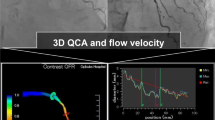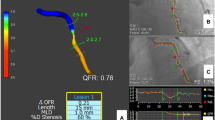Abstract
Quantitative flow ratio (QFR) is a computational measurement of FFR (fractional flow reserve), calculated from coronary angiography. Latest QFR software automates TIMI frame counting (TFC), which occurs during the flow step of QFR analyses, making the analysis faster and more reproducible. The objective is to determine the diagnostic performance of QFR values obtained from analyses using automatic TFC compared to those obtained from analyses using manual TFC. This was a single-arm clinical trial that used the prospective analysis of the coronary angiographic image series of 97 patients who underwent evaluation of stable coronary artery disease with FFR/iFR at MedStar Washington Hospital Center in Washington, DC, USA. Automatic and manual TFC QFR values were obtained from the analyses of each of the 97 patients’ image series, with manual TFC QFR values as the current gold standard for comparison. The diagnostic performance of automatic TFC QFR values was measured as follows: sensitivity was 0.87 (95% CI 0.66–0.97) and specificity was 1.00 (95% CI 0.9514–1.00), positive predictive value (PPV) was 1.00 (95%CI 1.00–1.00), while the NPV was 0.96 (95% CI 0.96–0.99). Overall accuracy was 96.91% (95% CI 91.23%–99.36%). The agreement as illustrated by the Bland–Altman plot shows a bias of 0.0023 (SD 0.0208) and narrow limits of agreement (LOA): Upper LOA 0.0573 and Lower LOA − 0.0528. The area under curve (AUC) was 0.996. QFR values generated from automatic TFC are comparable to those generated from manual TFC in diagnostic capability. The most recent software update produces values equivalent to those of the previous manual option, and can therefore be used interchangeably.




Similar content being viewed by others
References
Moscarella E, Gragnano F, Cesaro A, Ielasi A, Diana V, Conte M, Schiavo A, Coletta S, Di Maio D, Fimiani F, Calabrò P (2021) Coronary physiology assessment for the diagnosis and treatment of coronary artery disease. Cardiol Clin 38:575–588. https://doi.org/10.1016/j.ccl.2020.07.003
Nogic J, Prosser H, O’Brien J, Thakur U, Soon K, Proimos G, Brown AJ (2020) The assessment of intermediate coronary lesions using intracoronary imaging. Cardiovasc Diagn Ther. https://doi.org/10.21037/cdt-20-226
Zhang D, Lv S, Song X, Yuan F, Xu F, Zhang M, Yan S, Cao X (2015) Fractional flow reserve versus angiography for guiding percutaneous coronary intervention: a meta-analysis. Heart 101:455–462. https://doi.org/10.1136/heartjnl-2014-306578
Lawton JS, Tamis-Holland JE, Bangalore S, Bates ER, Beckie TM, Bischoff JM, Bittl JA, Cohen MG, DiMaio JM, Don CW, Fremes SE, Gaudino MF, Goldberger ZD, Grant MC, Jaswal JB, Kurlansky PA, Mehran R, Metkus TS Jr, Nnacheta LC, Rao SV, Sellke FW, Sharma G, Yong CM, Zwischenberger BA (2021) ACC/AHA/SCAI guideline for coronary artery revascularization. J Am Coll Cardiol 79:21–129. https://doi.org/10.1016/j.jacc.2021.09.006
Çimen S, Gooya A, Grass M, Frangi AF (2016) Reconstruction of coronary arteries from X-ray angiography: a review. Med Image Anal 32:46–68. https://doi.org/10.1016/j.media.2016.02.007
Tu S, Barbato E, Köszegi Z, Yang J, Sun Z, Holm NR, Tar B, Li Y, Rusinaru D, Wijns W, Reiber JHC (2014) Fractional flow reserve calculation from 3-dimensional quantitative coronary angiography and TIMI frame count. JACC Cardiovasc Interv 7:768–777. https://doi.org/10.1016/j.jcin.2014.03.004
Xu B, Tu S, Qiao S, Qu X, Chen Y, Yang J, Guo L, Sun Z, Li Z, Tian F, Fang W, Chen J, Li W, Guan C, Holm NR, Wijns W, Hu S (2017) Diagnostic accuracy of angiography-based quantitative flow ratio measurements for online assessment of coronary stenosis. J Am Coll Cardiol 70:3077–3087. https://doi.org/10.1016/j.jacc.2017.10.035
Cerrato E, Mejía-Rentería H, Franzè A, Quadri G, Belliggiano D, Biscaglia S, Lo Savio L, Spataro F, Erriquez A, Giacobbe F, Vergara-Uzcategui C, di Girolamo D, Tebaldi M, Varbella F, Campo G, Escaned J (2021) Quantitative flow ratio as a new tool for angiography-based physiological evaluation of coronary artery disease: a review. Future Cardiol 17:1435–1452. https://doi.org/10.2217/fca-2020-0199
Westra J, Tu S, Campo G, Qiao S, Matsuo H, Qu X, Koltowski L, Chang Y, Liu T, Yang J, Andersen BK, Eftekhari A, Christiansen EH, Escaned J, Wijns W, Xu B, Holm NR (2019) Diagnostic performance of quantitative flow ratio in prospectively enrolled patients: an individual patient-data meta-analysis. Catheter Cardiovasc Interv 94:693–701. https://doi.org/10.1002/ccd.28283
Finizio M, Melaku GD, Kahsay Y, Beyene S, Kuku KO, Ben-Dor I, Hashim H, Waksman R, Garcia-Garcia HM (2021) Comparison of quantitative flow ratio and invasive physiology indices in a diverse population at a tertiary United states hospital. Cardiovasc Revasc Med 32:1–4. https://doi.org/10.1016/j.carrev.2021.06.115
Xing Z, Pei J, Huang J, Hu X, Gao S (2019) Diagnostic performance of QFR for the evaluation of intermediate coronary artery stenosis confirmed by fractional flow reserve. Braz J Cardiovasc Surg. https://doi.org/10.21470/1678-9741-2018-0234
Xu B, Tu S, Song L, Jin Z, Yu B, Fu G, Zhou Y, Wang J, Chen Y, Pu J, Chen L, Qu X, Yang J, Liu X, Guo L, Shen C, Zhang Y, Zhang Q, Pan H, Fu X, Liu J, Zhao Y, Escaned J, Wang Y, Fearon WF, Dou K, Kirtane A, Wu Y, Serruys PW, Yang W, Wijns W, Guan C, Leon MB, Qiao S, Stone GW (2021) Angiographic quantitative flow ratio-guided coronary intervention (FAVOR III China): a multicentre, randomised, sham-controlled trial. The Lancet 398:2149–2159. https://doi.org/10.1016/S0140-6736(21)02248-0
Zuo W, Yang M, Chen Y, Xie A, Chen L, Ma G (2019) Meta-analysis of diagnostic performance of instantaneous wave-free ratio versus quantitative flow ratio for detecting the functional significance of coronary stenosis. BioMed Res Int. https://doi.org/10.1155/2019/5828931
Westra J, Tu S, Winther S, Nissen L, Vestergaard M-B, Andersen BK, Holck EN, Maule CF, Johansen JK, Andreasen LN, Simonsen JK, Zhang Y, Kristensen SD, Maeng M, Kaltoft A, Terkelsen CJ, Krusell LR, Jakobsen L, Reiber JHC, Lassen JF, Böttcher M, Bøtker HE, Christiansen EH, Holm NR (2018) Evaluation of coronary artery stenosis by quantitative flow ratio during invasive coronary angiography: the WIFI II study (wire-free functional imaging II). Circ Cardiovasc Imaging. https://doi.org/10.1161/CIRCIMAGING.117.007107
Cortés C, Carrasco-Moraleja M, Aparisi A, Rodriguez-Gabella T, Campo A, Gutiérrez H, Julca F, Gómez I, San Román JA, Amat-Santos IJ (2020) Quantitative flow ratio-meta-analysis and systematic review. Catheter Cardiovasc Interv 97:807–814. https://doi.org/10.1002/ccd.28857
Edep ME, Guarneri EM, Teirstein PS, Phillips PS, Brown DL (1999) Differences in TIMI frame count following successful reperfusion with stenting or percutaneous transluminal coronary angioplasty for acute myocardial infarction. Am J Cardiol 83:1326–1329. https://doi.org/10.1016/S0002-9149(99)00094-6
Gibson CM, Cannon CP, WiL D, Dodge JT Jr, Alexander B, Marble SJ, McCabe CH, Raymond L, Fortin T, Poole WK, Braunwald E (1996) TIMI frame count: a quantitative method of assessing coronary artery flow. Circulation 93:879–888. https://doi.org/10.1161/01.cir.93.5.879
Kunadian V, Harrigan C, Zorkun C, Palmer AM, Ogando KJ, Biller LH, Lord EE, Williams SP, Lew ME, Ciaglo LN, Buros JL, Marble SJ, Gibson WJ, Gibson CM (2008) Use of the TIMI frame count in the assessment of coronary artery blood flow and microvascular function over the past 15 years. J Thromb Thrombolysis 27:316. https://doi.org/10.1007/s11239-008-0220-3
Manginas A, Gatzov P, Chasikidis C, Voudris V, Pavlides G, Cokkinos D (1999) Estimation of coronary flow reserve using the thrombolysis in myocardial infarction (TIMI) frame count method. Am J Cardiol 83:1562–1565. https://doi.org/10.1016/s0002-9149(99)00149-6
Faile BA, Guzzo JA, Tate DA, Nichols TC, Smith SC, Dehmer GJ (2000) Effect of sex, hemodynamics, body size, and other clinical variables on the corrected thrombolysis in myocardial infarction frame count used as an assessment of coronary blood flow. Am Heart J 140:308–314. https://doi.org/10.1067/mhj.2000.108003
Abaci A, Oguzhan A, Eryol NK, Ergin A (1999) Effect of potential confounding factors on the thrombolysis in myocardial infarction (TIMI) trial frame count and its reproducibility. Circulation 100:2219–2223. https://doi.org/10.1161/01.cir.100.22.2219
French J, Ellis C, Williams B, Amos D, Ramanathan K, Whitlock R, White H (1998) Abnormal coronary flow in infarct arteries 1 year after myocardial infarction is predicted at 4 weeks by corrected thrombolysis in myocardial infarction (TIMI) frame count and stenosis severity. Am J Cardiol 81:665–671. https://doi.org/10.1016/s0002-9149(97)01004-7
Stankovic G, Manginas A, Voudris V, Pavlides G, Athanassopoulos G, Ostojic M, Cokkinos D (2000) Prediction of restenosis after coronary angioplasty by use of a new index: TIMI frame count/minimal luminal diameter ratio. Circulation 101:962–968. https://doi.org/10.1161/01.cir.101.9.962
Appleby MA, Michaels AD, Chen M, Gibson CM (2000) Importance of the TIMI frame count: implications for future trials. Curr Control Trials Cardiovasc Med 1:31–34. https://doi.org/10.1186/cvm-1-1-031
ten Brinke GA, Slump CH, Stoel MG (2012) Automated TIMI frame counting using 3-d modeling. Comput Med Imaging Graph 36:580–588. https://doi.org/10.1016/j.compmedimag.2012.07.001
Westra J, Sejr-Hansen M, Koltowski L, Mejía-Rentería H, Tu S, Kochman J, Zhang Y, Liu T, Campo G, Hjort J, Mogensen LJH, Erriquez A, Andersen BK, Eftekhari A, Escaned J, Christiansen EH, Holm NR (2022) Reproducibility of quantitative flow ratio: the QREP study. EuroIntervention 17:1252–1259. https://doi.org/10.4244/EIJ-D-21-00425
Acknowledgements
Ron Waksman: Advisory Board: Abbott Vascular, Amgen, Boston Scientific, Cardioset, Cardiovascular Systems Inc., Medtronic, Philips, Pi-Cardia Ltd.; Consultant: Abbott Vascular, Amgen, Biotronik, Boston Scientific, Cardioset, Cardiovascular Systems Inc., Medtronic, Philips, Pi-Cardia Ltd., Transmural Systems; Grant Support: AstraZeneca, Biotronik, Boston Scientific, Chiesi; Speakers Bureau: AstraZeneca, Chiesi; Investor: MedAlliance; Transmural Systems.
Hector Garcia: Grant to Institution: Medtronic, Biotronik, Neovasc, Boston Scientific, Abbott, Shockwave, Chiesi and Phillips. Consultant to Boston Scientific and ACIST. All other authors report no relevant disclosures.
Funding
There is no funding associated with this work.
Author information
Authors and Affiliations
Contributions
All authors contributed to the study design and planning, AD. conducted all QFR analyses, data collection, statistical analyses, and created the images and figures, and first draft of the manuscript. All authors contributed to the final draft of the manuscript and provided commentary and edits prior to submission. All authors have reviewed and approved the final version of the manuscript.
Corresponding author
Ethics declarations
Competing interests
The authors declare no competing interests.
Conflict of interest
The authors declare that they have no conflict of interest.
Ethical approval
Ethical approval was obtained from Institutional Review Board of Washington Hospital Center. The Washington Hospital Center Ethics Committee provided approval prior to study initiation.
Informed consent
Informed consent was obtained from all patients included in this study.
Additional information
Publisher's Note
Springer Nature remains neutral with regard to jurisdictional claims in published maps and institutional affiliations.
Rights and permissions
About this article
Cite this article
Devineni, A., Levine, M.B., Melaku, G.D. et al. Diagnostic comparison of automatic and manual TIMI frame-counting-generated quantitative flow ratio (QFR) values. Int J Cardiovasc Imaging 38, 1663–1670 (2022). https://doi.org/10.1007/s10554-022-02666-0
Received:
Accepted:
Published:
Issue Date:
DOI: https://doi.org/10.1007/s10554-022-02666-0




